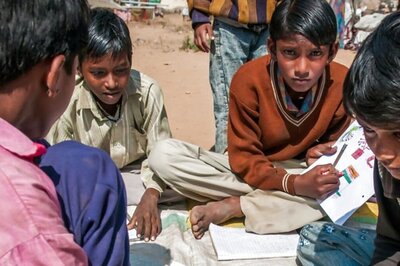
views
Many people living in tropical regions like India are likely to be exposed to “dangerously high” heat levels during most days of each typical year in the coming decades, warn scientists in their latest study on impact of climate change. For some places, the threshold could breach anywhere between 25-50% of the days in a year.
The findings in the peer-reviewed journal Communications Earth & Environment published by Nature attempted to show how increase in human-induced CO2 emissions this century would drive the Heat Index — a metric that quantifies heat exposure in human beings.
“In the tropics and subtropics, where the dangerous Heat Index threshold was typically exceeded on less than 15% of the days in each year between 1979 and 1998, we project that, by 2050, many people living in these regions will likely experience dangerous Heat Index values for half the year,” the study states.
Additionally, deadly heat waves, which are currently rare in the mid-latitudes covering East Asia, Central Asia, Central and Eastern Europe could become annual occurrences.
RISE IN HEAT-RELATED ILLNESSES
The findings emerge at a time when a series of deadly heat waves have impacted major cities across the world this summer. India recorded its hottest March in almost a century, amid a blistering heat wave that swept the country much earlier than usual. Prolonged heat waves also scorched Europe, North Africa, Middle East and other parts of Asia, testing the endurance limit of people.
If the greenhouse emissions are not curtailed as aggressively as they should, then these high temperatures will pose a threat to public health, with extreme heat contributing to heat cramps, heat exhaustion, and chronic illnesses. Not only this, but their intensification could threaten the agricultural systems and even inhabitability of large areas across countries, the study highlights.
India was witness to the impact of the searing heat wave on the agricultural production this summer as farmers across northern states reported steep decline in the overall yield and quality of wheat, threatening food security.
“Without adaptation measures, there may be large increases in the incidence of heat-related illnesses — particularly in the elderly, outdoor workers, and those with lower income,” the paper highlighted, calling upon countries to set more ambitious targets to reduce emissions.
CLOSING WINDOW
The researchers from Harvard University and University of Washington who led the study also estimate there is only a 0.1 per cent chance of limiting global average warming to 1.5°C by 2100, in line with the updated Paris Climate Agreement goal.
“Even if the Paris Agreement goal of limiting global warming to 2°C is met, the exposure to dangerous Heat Index levels will likely increase by 50–100% across much of the tropics and increase by a factor of 3–10 in many regions throughout the mid-latitudes,” they add.
Anthropogenic emissions have already warmed the planet by roughly 1.0 °C as of 2000–2020 relative to 1850–1900 baseline, and according to the study, it is likely to cross 2°C by 2050.
The team had analysed predictions from global climate models with human population projections and connected them to local changes in temperature and relative humidity to better quantify the degree to which climate change will increase human heat stress.
Read all the Latest News India and Breaking News here



















Comments
0 comment